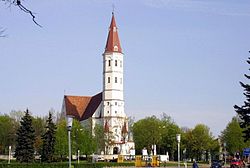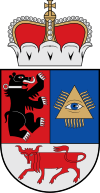Šiauliai
| Šiauliai | |||
|---|---|---|---|
| City municipality | |||

Cathedral of Šiauliai
|
|||
|
|||
| Nickname(s): Saulės miestas (The Sun City) | |||
| Location of Šiauliai | |||
| Coordinates: 55°56′N 23°19′E / 55.933°N 23.317°ECoordinates: 55°56′N 23°19′E / 55.933°N 23.317°E | |||
| Country |
|
||
| Ethnographic region | Samogitia | ||
| County | Šiauliai County | ||
| Municipality | Šiauliai city municipality | ||
| Capital of |
Šiauliai County Šiauliai city municipality Šiauliai district municipality |
||
| First mentioned | 1236 | ||
| Granted city rights | 1589 | ||
| Elderships | Medelynas eldership, Rėkyva eldership | ||
| Area | |||
| • Total | 81.13 km2 (31.32 sq mi) | ||
| Elevation | 151 m (495 ft) | ||
| Population (2016-01-20) | |||
| • Total | 102,983 | ||
| • Density | 1,300/km2 (3,300/sq mi) | ||
| Time zone | EET (UTC+2) | ||
| • Summer (DST) | EEST (UTC+2) | ||
| Postal code | 76xxx | ||
| Area code(s) | (+370) 41 | ||
| Vehicle registration | S | ||
| Website | www |
||
Šiauliai ([ʃɛʊ̯ˈlʲɛɪ̯ˑ]) is the fourth largest city in Lithuania, with a population of 133,900. From 1994 to 2010 it was the capital of Šiauliai County. Unofficially, the city is the capital of Northern Lithuania.
Šiauliai is referred to by a various names in different languages: Samogitian Šiaulē, Latvian Saule (historic) and Šauļi (modern), German (outdated) Schaulen, Polish Szawle, Russian Шавли (Shavli — historic) and Шяуля́й (Shyaulyai — modern), Yiddish שאַװל (Shavel).
The city was first mentioned in written sources as Soule in Livonian Order chronicles describing the Battle of Saule. Thus the city's founding date is now considered to be September 22, 1236, the same date when the battle took place, not far from Šiauliai. At first it developed as a defense post against the raids by the Teutonic and Livonian Orders. After the battle of Grunwald in 1410, the raids stopped and Šiauliai started to develop as an agricultural settlement. In 1445, a wooden church was built. It was replaced in 1625 with the brick church which can be seen in the city center today.
Šiauliai was granted Magdeburg city rights in the 16th century, when it also became an administrative center of the area. However, in the 16th to 18th centuries the city was devastated by The Deluge and epidemics of the Bubonic plague.
The credit for the city's rebirth goes to Antoni Tyzenhaus (1733–1785) who after a violent revolt of peasants of the Crown properties in the Northern Lithuania (so-called in Polish: Powstanie Szawelskie, 1769), started the radical economic and urban reforms. He decided to rebuild the city according to the Classicism ideas: at first houses were built randomly in a radial shape, but Tyzenhaus decided to build the city in an orderly rectangular grid. Šiauliai grew to become a well-developed city, with several prominent brick buildings. In 1791 Stanisław August Poniatowski, king of the Polish–Lithuanian Commonwealth, confirmed once again that Šiauliai's city rights and granted it a coat of arms which depicted a bear, the symbol of Samogitia, the Eye of Providence, and a red bull, the symbol of the Poniatowski family. The modern coat of arms has been modeled after this version.
...
Wikipedia



